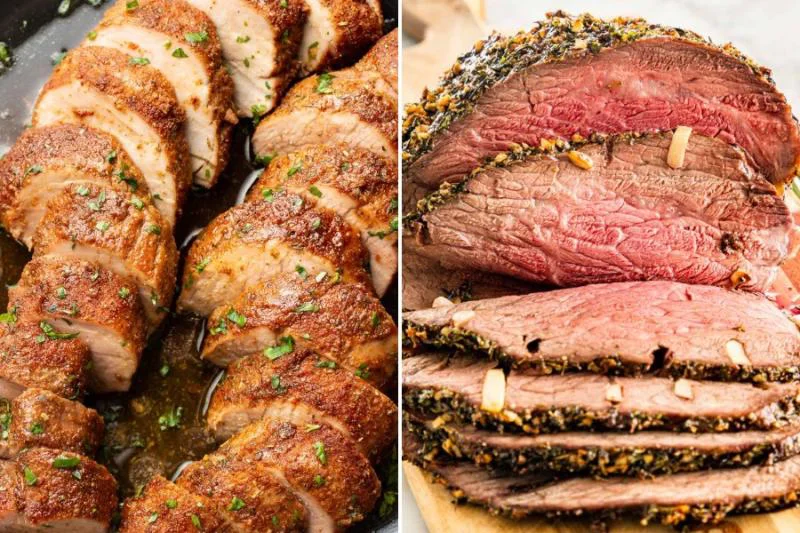Pork and beef are popular kinds of meat, but they are not the same. Beef comes from cattle, while pork comes from pigs. Pork is usually milder and sweeter, while beef has a stronger, richer flavour. Pork is healthier because it has more unsaturated fats than beef, which has more saturated fats. This difference in fat content affects how they cook. Pork is more tender and juicy, while beef needs to be cooked slower to get tender. Also, pork is often considered “white meat,” while beef is called “red meat” because it is darker.
What is Pork?
Pork refers to meat from domesticated pigs (Sus scrofa domesticus). It is one of the most popular meats in the world due to its soft, juicy texture and mild, sweet flavour. Each pork cut, such as chops, tenderloin, ribs, shoulder, and belly, has its cooking techniques and culinary applications.
Pork is a versatile meat that may be prepared in various ways, such as grilling, roasting, frying, and slow cooking. In addition, it is the principal ingredient in numerous processed meat products, such as sausages, gammon, and bacon.
Pork is an excellent source of protein, essential vitamins, and minerals, such as B vitamins, iron, and zinc. However, depending on the cut, its fat content and quality can vary. Leaner cuts, such as tenderloin, contain less fat and are considered healthier, but fattier cuts, like the belly, include more saturated and unsaturated fats.
Pork needs to be cooked all the way through to kill harmful pathogens, like the parasite Trichinella spiralis, which can cause trichinosis, that could be spread through food. Pork, when correctly prepared, is a delicious and nutritious source of protein that may be incorporated into a healthy diet.
What is Beef?
Beef is the culinary name for meat derived from domesticated bovines (Bos taurus and Bos indicus). It is a globally popular source of protein, renowned for its robust, rich flavour and varied degrees of tenderness depending on the cut. Steaks, ribs, roasts, and ground beef are common beef cuts that can be prepared in various ways, including grilling, roasting, braising, and stewing.
The adaptability of beef makes it a staple in various cuisines, including steak meals, slow-cooked pot roasts, stews, and ground beef in burgers or tacos. Moreover, it is a key component of processed meats such as sausages, corned beef, and beef jerky.
Beef is a rich source of high-quality protein, vitamins (especially B vitamins), minerals (including iron, zinc, and selenium), and essential amino acids. However, the fat level in beef varies depending on the cut, marbling, and cooking method. While lean cuts include less fat and are healthier, fattier cuts contain more saturated fat.
As red meat, excessive beef consumption has been associated with health risks, including an increased risk of heart disease and some malignancies. But beef can contribute to a healthy lifestyle and supply essential nutrients when consumed in moderation and as part of a balanced diet.
Difference Between Pork and Beef
Pork originates from pigs and is sweeter and less robust in flavour than beef, which comes from cattle. Unsaturated fatty acids are more prevalent in pork, while saturated fatty acids are more prevalent in beef. Pork is commonly called “white meat,” whereas beef is known as “red meat” due to its darker colour. Pork is naturally more tender than beef because of differences in fat composition and colour, while beef needs to be cooked longer to get the same level of tenderness. Here are some of the most salient distinctions between pork and beef:
Source
Pigs are the source of pork, while cattle are the source of beef.
Flavour
The pork flavour is softer and sweeter than beef, which is richer and stronger.
Colour
Some people refer to pork as “white meat” because of its lighter colour, while others refer to beef as “red meat” due to its deeper colour.
Fat Content
Pork often has more unsaturated fats, while beef is richer in saturated fats.
Fat Distribution
Fat marbling occurs more frequently in pork than in beef; in both cases, it is mainly found in pork than in beef.
Tenderness
Compared to beef, which may need to be cooked more slowly to get tender, pork tends to be more tender and succulent.
Cooking Methods
Beef is often prepared on the grill, but pork can be prepared in various ways, including roasting, frying, and slow cooking.
Nutrient Profile
Both pork and beef are good sources of protein and minerals, but beef has more iron and zinc and is a better source of B vitamins.
Health Concerns
Compared to pork, which is considered white meat, the health concerns connected with eating excessive beef are higher because of its red meat classification.
Cuts
Pork is typically prepared as chops, tenderloin, or ribs, while beef is generally prepared as steaks, roasts, or ground beef.
Processed Meat Products
Ham, bacon, and the vast majority of sausages are made with pork, while corned beef, beef jerky, and some sausages are made with beef.
Foodborne Pathogens
Although beef is less sensitive to Trichinella spiralis than pork, it must be adequately cooked to eradicate pathogens like bacteria.







